The EUR/USD keeps moving around the 1.0600 mark. The crucial US inflation report did not help traders, neither bears nor the bulls. On the one hand, the report came out at the forecasted level, but on the other hand, it reflected the slowdown of the index. That's why the reaction was short-term: the price surged from 1.0598 to 1.0635, but returned to the base of the 6th figure in just half an hour. This suggests that market participants are not ready to open large positions, neither in favor of the dollar, nor against it. Especially in the run-up to the long Christmas weekend.

But back to Friday's release. First of all, take note that the Personal Consumption Expenditures (PCE) Index has very powerful potential in the context of influencing the dynamics of dollar pairs. It is the Federal Reserve's preferred inflation indicator and is closely monitored by members of the US central bank. That's why any deviation from the forecasted scenario usually causes a strong volatility in EUR/USD (and the rest of the dollar pairs). However, the results of the latest report coincided with the projections.
The Core PCE was up 0.2% on a monthly basis. This component of the release has slowed for the second straight month. Annually, it slowed to 4.7%. There is also a consistent downtrend here. After peaking in September (5.2%), it is gradually decreasing: the indicator came out at 5.0% in October, and at 4.7% in November.
The slowdown in annual core PCE inflation is consistent with a slowdown in the U.S. Consumer Price Index (CPI). The core inflation report for November, released on December 13, was again in the red: all components fell short of forecast levels, thus confirming a slowdown in U.S. inflation. The CPI came in at 7.1% in November, while the forecast was for a slowdown to 7.3%. This was the fifth straight month of declines after peaking at 9.1%. On a monthly basis, the overall CPI was also in the red, rising 0.1% (the forecast was 0.3%). In turn, the core CPI, which excludes food and energy prices, showed a similar trend: on an annualized basis it rose in November by 6.0%, whereas most experts forecasted an increase to 6.5%.
As we see, the key indicators of the U.S. inflation rate are coherently decreasing, allowing the Fed to reduce the "degree of aggressiveness" of the rate hike. If this trend continues, the Fed is likely to make other similar decisions. Let me remind you that at the end of the December meeting, Fed Chairman Jerome Powell said that members of the central bank may revise the forecast of the final rate downward if the central bank continues to see weak data on inflation. According to the Fed chair, the current monetary policy is still "not restrictive enough," but the effect of its tightening the U.S. economy "yet to be felt". And in this context, he voiced the key phrase of his entire speech, saying that the pace of rate hikes is no longer decisive, and decisions to raise the rate will be made at each specific meeting depending on the incoming data.
Such verbal signals suggest that the Fed may slow the pace of rate hikes to 25 points early next year, as well as lower the forecast for the final rate (currently at 5.1%).
Yet despite the slowdown in the underlying PCE index, traders are hesitant to play against the dollar ahead of the extended weekend (Christmas on Sunday and the U.S. trading floors will be closed on Monday).
But traders are indecisive not only because of the weekend factor. In my opinion, the Covid factor amid the recent events in China also weigh on the pair.
Thus, according to Bloomberg, nearly 37 million people in China may have been infected with COVID-19 on a single day (on December 20) this week. A sharp increase in the number of cases occurred after strict quarantine measures in China were eased. This is unofficial information (officially the Chinese authorities have confirmed only 3,000 cases since the beginning of December), but nevertheless it provoked a surge of anti-risk sentiment in the market. It is reported that the coronavirus crisis has taken on a "completely unprecedented scale in the entire pandemic". For comparison, before December 20, the peak number of infections in China was recorded in January: then the daily increase was 4 million.
Apparently, it will only get worse, forcing Beijing to tighten the screws in the context of strengthening quarantine restrictions. This fact will play against the bulls, as the dollar will be in high demand as a defensive instrument.
Thus, given the contradictory fundamental background, EUR/USD, most likely, will continue to trade in a price range of 1.0550-1.0660 in the medium term. It is better to open shorts at the upper limit of this range, buying, respectively, - near the lower limit of the price echelon.





















